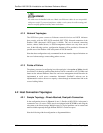
Chapter 3: Subsystem Monitoring
after a few seconds.
Note that restoring default will not affect the
existing RAID configurations of disk drives.
Table 3-3: Controller LED Definitions
Restore NVRAM Defaults – a Push Button
CAUTION!
The Restore NVRAM Default push button is a function that carries some
risks. Firmware restoration will not destroy the existing logical drive
configurations; however, if the existing logical drives cannot be
adequately associated with host ID/LUNs after firmware default
restoration, data loss or inconsistencies might occur.
There is a non-latch type push button accessed through a round opening
underneath the Restore Default LED.
Listed below are the necessary procedures that should be
completed before using this button:
1. Before pressing this button to restore firmware defaults, it is highly advised
to make a list of the existing ID/LUN mapping information. You will need
the list for restoring ID/LUN mapping after restoring defaults. Default
restoration will erase the ID/LUN mapping associations (e.g., which logical
drive is associated with which host ID/LUN), and it is necessary to restore
the host ID/LUN mapping after firmware default restoration in order to
access data on the previously configured arrays.
2. Some of the latest firmware updates may be incompatible with the firmware
currently running on your subsystem. These updates may require restoring
firmware defaults before firmware upgrade can actually take place. Before
using the button, it is highly advised to practice the following:
Stop host I/Os,
Backup your data,
Make a list of host ID/LUN mapping information for future
references.
You may also jot down the configured parameters such as the
performance preferences, specific stripe sizes, etc.
3. The no. 3 condition that requires restoring defaults is when an administrator
forgets the password configured to control the access to a RAID subsystem.
Before pushing this button, also practice the steps listed above. You can
access array information even without a password.
Status-indicating LEDs
3-5


















